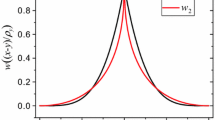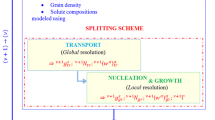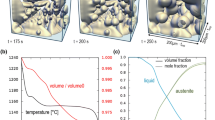Abstract
This work presents a strong form meshfree collocation method for a multi-phase field model with finite dissipation effects due to rapid solidification. We use the collocation method to simulate and study solidification of a low concentration (0.2 at% Sn) Al–Sn binary alloy system under periodic boundary conditions to address non-equilibrium solidification. Numerical implementation takes place through spatial discretization of the governing equations with the collocation method followed by application of the Crank–Nicolson method to integrate through time. Analysis begins with a benchmark, a simple two-grain case with symmetry in domain size, grain positioning, and boundary conditions to study the behavior of the field equations and key terms embedded within. This occurs by studying field and embedded term values along the axis of symmetry. Solidification analysis is then extended for 10 and 20 grains where upon full solidification, the regions with the highest overall concentrations exist within grain boundary region consisting for four or more adjacent grains. An analysis of alloy solidification over a substrate demonstrates epitaxial nucleation and growth.









Similar content being viewed by others
References
Minkoff I (1992) Solidification/liquid state processes. Springer, Berlin, pp 1–31
Shahnooshi E, Jamshidian M, Jafari M, Ziaei-Rad S, Rabczuk T (2019) Phase field modeling of stressed grain growth: effect of inclination and misorientation dependence of grain boundary energy. J Cryst Growth 518:18–29
Michopoulos J, Iliopoulos A, Steuben J, Birnbaum A, Apetre N, Song J-H, Yao F, Achuthan A, Saunders R, Bagchi A, Fonda R, Rowenhorst D, Olig S, Martin F, Moran J, Ntiros A (2021) Multiphysics integrated computational materials engineering linking additive manufacturing process parameters with part performance. In: Advances in computers and information in engineering research, volume 2. ASME, 06 (ISBN 9780791862025)
Aziz MJ, Smith PM (1994) Solute trapping in aluminum alloys. Acta Metall Mater 42(10):3515–3525
Aziz MJ, Boettinger WJ (1994) On the transition from short-range diffusion-limited to collision-limited growth in alloy solidification. Acta Metall Mater 42(2):527–537
Otooni MA (1998) Elements of rapid solidification: fundamentals and applications. Springer, Berlin
Buchmann M, Rettenmayr M (2007) Rapid solidification theory revisited—a consistent model based on a sharp interface. Scripta Mater 57(2):169–172
Steinbach I, Zhang L, Plapp M (2012) Phase-field model with finite interface dissipation. Acta Mater 60(6–7):2689–2701
Zhang ISL (2012) Phase-field model with finite interface dissipation: extension to multi-component multi-phase alloys. Acta Mater 60(6):2702–2710
Reuther K, Hubig S, Steinbach I, Rettenmayr M (2019) Solute trapping in non-equilibrium solidification: a comparative model study. Materialia 6:100256
Langer JS (1986) Models of pattern formation in first-order phase transitions. Directions in condensed matter physics: memorial in Honor of Shang-Keng Ma, vol in. World Scientific, Singapore, pp 165–186
Caginalp G (1989) Stefan and hele-shaw type models as asymptotic limits of the phase-field equations. Phys Rev A 39(11):5887
Kobayashi R (1993) Modeling and numerical simulations of dendritic crystal growth. Phys D 63(3–4):410–423
Wheeler AA, Boettinger WJ, McFadden GB (1992) Phase-field model for isothermal phase transitions in binary alloys. Phys Rev A 45(10):7424
Wheeler AA, Boettinger WJ, McFadden GB (1993) Phase-field model of solute trapping during solidification. Phys Rev E 47(3):1893
Boettinger WJ, Wheeler AA, Murray BT, McFadden GB (1994) Prediction of solute trapping at high solidification rates using a diffuse interface phase-field theory of alloy solidification. Mater Sci Eng A 178(1–2):217–223
Karma A (1994) Phase-field model of eutectic growth. Phys Rev E 49(3):2245
Elder KR, Gunton JD, Grant M (1996) Nonisothermal eutectic crystallization. Phys Rev E 54(6):6476
WheelerAdam A, McFadden GB, Boettinger WJ (1996) Phase-field model for solidification of a eutectic alloy. Proc R Soc Lond Ser A Math Phys Eng Sci 452(1946):495–525
Warren James A, Boettinger William J (1995) Prediction of dendritic growth and microsegregation patterns in a binary alloy using the phase-field method. Acta Metall Mater 43(2):689–703
Jamshidian M, Thamburaja P, Rabczuk T (2016) A multiscale coupled finite-element and phase-field framework to modeling stressed grain growth in polycrystalline thin films. J Comput Phys 327:779–798
Yoon Y-C, Song J-H (2014a) Extended particle difference method for weak and strong discontinuity problems: part. I. Derivation of the extended particle derivative approximation for the representation of weak and strong discontinuities. Comput Mech 53(6):1087–1103
Yoon Y-C, Song J-H (2014b) Extended particle difference method for weak and strong discontinuity problems: part II. Formulations and applications for various interfacial singularity problems. Comput Mech 53(6):1105–1128
Yoon Y-C, Song J-H (2014c) Extended particle difference method for moving boundary problems. Comput Mech 54(3):723–743
Yoon Y-C, Song J-H (2021) Interface immersed particle difference method for weak discontinuity in elliptic boundary value problems. Comput Methods Appl Mech Eng 375:113650
Almasi A, Kim T-Y, Laursen TA, Song J-H (2019a) A strong form meshfree collocation method for frictional contact on a rigid obstacle. Comput Methods Appl Mech Eng 357:112597
Song J-H, Yao F, Kim T-Y, Yoon Y-C, Michopoulos JG, Rabczuk T (2018) Phase field simulations of coupled microstructure solidification problems via the strong form particle difference method. Int J Mech Mater Des 14(4):491–509
Almasi A, Beel A, Kim T-Y, Michopoulos JG, Song J-H (2019b) Strong-form collocation method for solidification and mechanical analysis of polycrystalline materials. J Eng Mech 145(10):04019082
Yoon Y-C, Schaefferkoetter P, Rabczuk T, Song J-H (2019) New strong formulation for material nonlinear problems based on the particle difference method. Eng Anal Bound Elem 98:310–327
Beel A, Kim T-Y, Jiang W, Song J-H (2019) Strong form-based meshfree collocation method for wind-driven ocean circulation. Comput Methods Appl Mech Eng 351:404–421
Almasi A, Kim T-Y, Laursen TA, Song J-H (2019c) A strong form meshfree collocation method for frictional contact on a rigid obstacle. Comput Methods Appl Mech Eng 357:112597
Yang X, Han D (2017) Linearly first-and second-order, unconditionally energy stable schemes for the phase field crystal model. J Comput Phys 330:1116–1134
Thomas JW (2013) Numerical partial differential equations: finite difference methods, vol 22. Springer, Berlin
Saundersc N (1998) Cost 507: thermochemical database for light metal alloys. European Commission, Brussels, pp 23–27
Lippold JC (2015) Welding metallurgy and weldability. Wiley, New York
Jamshidian M, Rabczuk T (2014) Phase field modelling of stressed grain growth: analytical study and the effect of microstructural length scale. J Comput Phys 261:23–35
Liu W-K, Li S, Belytschko T (1997) Moving least-square reproducing kernel methods (i) methodology and convergence. Comput Methods Appl Mech Eng 143(1–2):113–154
Salari K, Knupp P (2000) Code verification by the method of manufactured solutions. Sandia National Labs., Albuquerque, NM, USA, Technical report
Acknowledgements
The second and third authors acknowledge support for this work by the Office of Naval Research (ONR) through the Naval Research Laboratory’s core funding, and the second author also acknowledges the financial support of the Office of Naval Research under the Agile ICME Toolkit project (N0001420WX00405).
Author information
Authors and Affiliations
Corresponding author
Additional information
Publisher's Note
Springer Nature remains neutral with regard to jurisdictional claims in published maps and institutional affiliations.
Appendices
Appendix 1: Implementation of the Gibbs free energy
The bulk (Gibbs) free energy \(f_{\gamma }\) for phase \({\gamma }\) evaluated in this work are based on the experimental thermo-chemical data and methods provided within the COST-507 [34]. Data consists of a collection of coefficients and interaction parameters used to calculate free energies of pure element and multi-component systems. The coefficients are temperature T dependent and are used with the power series to evaluate the molar free energy g for a pure species i in phase \({\gamma }\) with respect to its stable state enthalpy; i.e.
The free energy of multi-component system consists of contributions from each constituent species within the mixture and of mixing between species. Contributions from mixing are further classified as either ideal or non-ideal where the latter is modeled with a Redlich-Kister polynomial that contains temperature dependent interaction parameters \(L^\nu\). For a substitutional three-component alloy system, the free energy is given by
where the right hand side terms respectively correspond to the unmixed, ideal mixing, binary non-ideal, and ternary non-ideal mixing terms. Invoking the chain rule to differentiate Eq. (34) with respect to composition yields
with
Note that for the constraint, i.e. \(\sum x_i =1\) we use the conditional relation to implement Eq. (36) in our computational analysis program:
Figure 10 represents an output of the Al–Sn–Zn system along the Al–Zn, Zn–Sn, and Al–Sn surfaces for the liquid, FCC, BCT and HCP phases at a temperature of 600 K. Thermo-Calc plots are also presented for comparison. The derivatives used to construct the tangent lines for the Al–Zn (lower left plot) at \(x_{\text {Al}} = 0.2\) are based on Eq. (36).
Appendix 2: Verification of the discrete differential operators
One way to measure the validity of computed discretized differential operators is through its fundamental properties, i.e. consistency [37]. Let \(x_i\) where \(x_1 = x\) and \(x_2 = y\), and to ease notation let \(\Phi _{I}^{x_i} = \{\Phi _{I}^{(1,0)}, \Phi _{I}^{(1,0)}\}\) and \(\Phi _{I}^{x_i x_j} = \{\Phi _{I}^{(2,0)}, \Phi _{I}^{(1,1)}, \Phi _{I}^{(0,2)}\}\) represent the first and second order differential operator sets respectively. For any point \(p\in \bar{\Omega }\) such that \(0<p\le N\) with associated coordinate \(x^p_i\) following properties have been numerically verified:
-
1.
\(\sum _{I=1}^{N} \Phi _{I}^{(0,0)} = 1\),
-
2.
\(\sum _{I=1}^{N} \Phi (\mathbf{x} ^p)_{I}^{(0,0)}[x_i]_I = x_i\),
-
3.
\(\sum _{I=1}^{N} \Phi (\mathbf{x} ^p)_{I}^{x_j}[x_i]_I = \delta _{ij}\),
-
4.
\(\sum _{I=1}^{N} \Phi (\mathbf{x} ^p)_{I}^{x_i x_j}[x_i x_j]_I = 1\) if \(i \ne j\),
-
5.
\(\sum _{I=1}^{N} \Phi (\mathbf{x} ^p)_{I}^{x_i x_j}[x_i x_j]_I = 2\) if \(i = j\).
Note that there also exist similar properties for \({\mathbb {R}}^3\) domains and higher ordered derivatives (i.e \(m>2\)) as well.
Another way to measure the effectiveness of differential operators is through its interpolation error. This may be achieved by benchmarking solution data for a given partial differential equation against data from another known or trusted solution analytical, numerical, or manufactured solution. In this work, we take the latter approach by manufacturing and differentiating two primary fields c(x, y) and \(\phi (x,y)\) as shown in Eqs. (38) and (39) respectively to produce a term \(\nabla \cdot (\phi (x,y)\nabla c(x,y))\). The manufactured fields are variants of those taken from a helpful report on the method of manufactured solutions [38].
Figure 11 presents a comparison between analytical y and approximate solution \(y^h\) fields for the term \(\nabla (\phi (x,y) D\nabla c(x,y)\) which test all two-field first order derivative products, second order derivatives and combinations thereof; for the computation, an unit square domain is discretized with uniformly distributed 4900 collocation points. The computed discrete L2 norm error which is given by
was measured at a value less than 0.3%. Those who interested in the computational resources to construct differential operators are referred to Sect. 4 of this study.
Rights and permissions
About this article
Cite this article
Schaefferkoetter, P., Michopoulos, J.G. & Song, JH. Strong-form meshfree collocation method for non-equilibrium solidification of multi-component alloy. Engineering with Computers 39, 45–59 (2023). https://doi.org/10.1007/s00366-021-01503-7
Received:
Accepted:
Published:
Issue Date:
DOI: https://doi.org/10.1007/s00366-021-01503-7






